Melbourne: Scientists in Australia have discovered a galaxy as far as 5 billion light-years away by using a new hi tech radio telescope.
The galaxy was discovered in radio emission traveling to earth using the Australian Square Kilometer Array Pathfinder telescope (ASKAP).
Six dishes of the telescope, located in a remote desert in Western Australia at the Murchison Radio-astronomy Observatory (MRO), have detected a weak signal emitted prior to the birth of the solar system.
James Allison of Australia's national science agency's Commonwealth Scientific and Industrial Research Organisation (CSIRO) led a research team using ASKAP and MRO's unique radio quietness to crack open a window to a little-explored period of the universe's history.
"At many observatories, this dip would have been hidden by background radio noise, but our site is so radio quiet it stood out clearly," said Allison, an affiliate of ARC Centre of Excellence for All-sky Astrophysics (CAASTRO).
The telescope can pick up signals from galaxies in the distant universe that are sources of radio waves, said Elaine Sadler, professor of astrophysics at the University of Sydney.
The team used a special technique to detect a change in radio waves coming from within the bright center of the galaxy PKS B1740-517, located near the Ara constellation.
"If that radio signal passes through hydrogen gas, it makes a signature at one particular frequency, like tuning into a radio station. That can tell you the distance the hydrogen has traveled, and that's what this telescope measures," Sadler said.
The five-billion-year-old radio emission was stamped with the 'imprint' of hydrogen gas it had traveled through on its way to earth.
The gas absorbs some of the emission, creating a tiny dip in the signal.
Both the scientists are part of a team that will use the absorption technique with ASKAP to find hundreds of galaxies that are up to ten billion light years away and determine how much hydrogen gas they contain.
This will help astronomers understand why star formation, which is fueled by hydrogen gas, has dropped off in the universe since its peak 10 billion years ago.
















